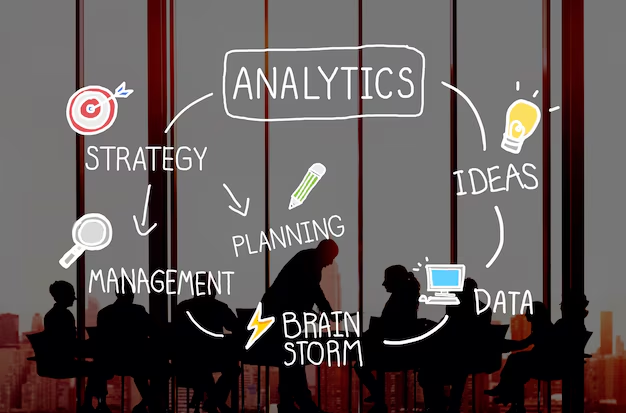In today’s data-driven world, businesses have access to an unprecedented volume of data, often referred to as “Big Data.” This vast amount of information provides an opportunity for organizations to gain deeper insights, make more informed decisions, and optimize their strategies. However, the challenge lies in efficiently analyzing, interpreting, and extracting value from this data. In this context, business analytics (BA) has evolved significantly, and several trends and insights have emerged.
Key Trends in Business Analytics
- The Rise of Artificial Intelligence (AI) and Machine Learning (ML)
- AI and ML are becoming central to business analytics. These technologies enable predictive analytics, automation of decision-making, and deeper insights from complex datasets.
- AI-driven tools can analyze large datasets faster and more accurately than traditional methods, helping businesses forecast trends and customer behavior with higher precision.
- Chatbots, recommendation engines, and fraud detection systems are just a few examples of AI applications in business analytics.
- Data Democratization
- Traditionally, business analytics was reserved for data scientists or IT professionals. However, with the advent of user-friendly tools and platforms, even non-technical employees can access, understand, and act on data insights.
- Cloud-based analytics solutions and platforms such as Microsoft Power BI, Tableau, and Google Analytics have made it easier for businesses to democratize data and make it accessible to everyone within the organization.
- Real-time Analytics
- The need for faster decision-making is driving the adoption of real-time analytics. Businesses can now analyze data in real time to optimize operations, enhance customer experience, and quickly adjust strategies.
- Real-time analytics are particularly valuable in industries like e-commerce, retail, and finance, where consumer preferences, inventory, and stock prices can change rapidly.
- Advanced Predictive Analytics
- Predictive analytics allows businesses to anticipate future trends, behaviors, and outcomes. By using historical data, statistical algorithms, and machine learning techniques, companies can predict customer preferences, product demand, and even market shifts.
- This trend is especially beneficial in sectors like supply chain management, marketing, and risk management, where anticipating future events can lead to significant cost savings and improved strategic planning.
- The Shift to Cloud-Based Analytics
- Cloud computing has revolutionized business analytics by offering scalable, flexible, and cost-effective solutions. Instead of relying on on-premises data storage and processing, businesses are now leveraging cloud platforms for data storage, analysis, and collaboration.
- Cloud-based solutions also promote collaboration across departments and geographies, enhancing decision-making and enabling more agile business practices.
- Data Privacy and Security Concerns
- With the rise of big data comes the responsibility to manage it securely and ethically. Data privacy regulations like GDPR and CCPA have forced businesses to rethink how they collect, store, and analyze customer data.
- Companies are increasingly investing in data encryption, secure access controls, and privacy compliance programs to mitigate risks associated with data breaches and misuse.
- Integration of IoT (Internet of Things) with Analytics
- The proliferation of IoT devices generates vast amounts of real-time data that businesses can leverage for decision-making. IoT analytics allows businesses to optimize operations, improve asset management, and enhance customer experiences.
- For example, manufacturing companies use IoT sensors to monitor equipment in real-time and predict maintenance needs, thus reducing downtime and improving efficiency.
Insights for Businesses in the Age of Big Data
- Data-Driven Decision-Making is Key
- The true value of big data comes from its ability to inform decisions. Companies that leverage data-driven insights are better equipped to identify opportunities, improve operational efficiency, and gain competitive advantages.
- Data analytics can help businesses optimize pricing strategies, identify new market segments, and personalize customer experiences, leading to higher customer satisfaction and loyalty.
- The Importance of Data Quality
- Big data’s effectiveness depends on the quality of the data being analyzed. Poor data quality—such as missing, inconsistent, or incorrect information—can lead to faulty insights and bad business decisions.
- Companies need to invest in data governance frameworks to ensure data accuracy, consistency, and reliability. This involves cleaning, validating, and continuously monitoring the data to maintain its integrity.
- Collaboration Between Departments
- As data analytics becomes more integrated into business operations, collaboration between departments like marketing, IT, finance, and HR is crucial. A siloed approach to data analysis can lead to missed opportunities and inefficiencies.
- Cross-functional teams should work together to ensure that insights are shared, and analytics are aligned with overall business goals and strategies.
- Visualization Tools Enhance Data Understanding
- Data visualization plays a crucial role in making complex analytics accessible and actionable. Interactive dashboards and visual reports help stakeholders understand patterns and trends quickly.
- By presenting data visually, businesses can make more informed decisions, communicate insights clearly, and enable executives to take immediate actions.
- Continuous Learning and Adaptation
- Business analytics is a dynamic field that continues to evolve. Companies must foster a culture of continuous learning, ensuring that employees stay up to date with the latest technologies and methodologies.
- Moreover, analytics models need to be updated regularly to account for changes in customer behavior, market trends, and other external factors.
- Ethical Considerations in Data Use
- As businesses collect more data, ethical concerns around privacy, bias, and fairness have gained prominence. Organizations must ensure that their data collection methods are transparent and that the data is used in an ethical and responsible manner.
- Companies that prioritize ethical data practices will build trust with customers, regulators, and other stakeholders.
Conclusion
Business analytics in the age of big data is transforming how organizations operate, make decisions, and compete in the marketplace. The ability to analyze vast amounts of data and derive actionable insights is critical to success in today’s fast-paced business environment. By embracing trends like AI and ML, real-time analytics, and cloud-based solutions, businesses can gain a competitive edge. However, ensuring data quality, security, and ethical practices will remain key to maintaining trust and driving sustainable growth in the future.

